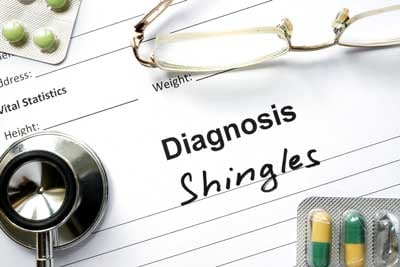 Nearly a third of the U.S. population will develop shingles, and almost half of all cases occur in people over the age of 60, according to the CDC. Let's take a closer look at this common disease, from signs and symptoms to prevention and treatment.
Nearly a third of the U.S. population will develop shingles, and almost half of all cases occur in people over the age of 60, according to the CDC. Let's take a closer look at this common disease, from signs and symptoms to prevention and treatment.
What is Shingles?
Also called zoster or herpes zoster, shingles is caused by the chickenpox virus. When you recover from chickenpox, the virus does not leave your body but instead becomes dormant. Years later -- for reasons unknown -- it can reactivate in the form of shingles.
Shingles is most known for causing a painful rash that develops on either the body or face. It typically occurs on just the left or right side, although in some cases it can be more widespread. Up to five days before the rash appears, it's common to feel tingling, itching, or pain at the future rash site. After the rash develops, it will form blisters, scab over, and eventually clear up within a month. Shingles can also be accompanied by fever, headache, chills, and upset stomach.
While the pain caused by shingles, known as postherpetic neuralgia (PHN), usually goes away with the rash, it can also last for weeks, months, or even years in extreme cases. In some cases, the pain becomes so severe that it can interfere with sleep and day-to-day activities, eventually leading to serious depression, according to the NIH.
As people age, they're more susceptible to developing longer-lasting bouts of severe pain from shingles. Additionally, a shingles occurrence near the face or eyes can permanently compromise vision and/or hearing.
While shingles itself is not contagious, the varicella-zoster virus is. It can be transmitted as chickenpox to people who have not had the disease.
Preventing Shingles
Because shingles can be quite painful and there is no cure for the disease, preventative measures are important. The single most important thing people can do to reduce their risk of developing the disease? Get vaccinated.
The CDC recommends that all people over the age of 60 receive one shingles vaccine dose. In fact, in clinical trials, the vaccine has been linked with reducing the risk of shingles by half. If you're unsure whether your aging loved one should get the shingles vaccine, talk to his/her healthcare provider.
Treatment for Shingles
A handful of antiviral meds are used to treat shingles, but these are not a cure. Rather, they can be useful in shortening both the length and severity of the disease. However, antiviral treatment is only effective if it begins with the onset of the rash, so it's critical to alert your aging loved one's healthcare provider as soon as you begin noticing symptoms.
Shingles can also be treated with over-the-counter pain medications and calamine lotion, as well as home remedies, like oatmeal baths and wet compresses.

In order to minimize pain and maximize treatment, prompt diagnosis is critical.
More than a million people in this country develop shingles every year, making it a significant threat to senior health. And while most people get shingles only one time, others have multiple episodes during their lifetimes. The vaccine is an invaluable part of minimizing the risk of shingles, along with unnecessary pain and suffering for seniors.
mmLearn.org offers a large library of free videos for caregivers of older adults, covering topics pertaining to senior care. Whether you are a healthcare professional or a family caregiver, if you are caring for an older adult we know that you will find mmLearn.org an essential learning and guidance tool for all of your caregiver training needs. Access our free online caregiver videos today for more useful information for caregivers.
